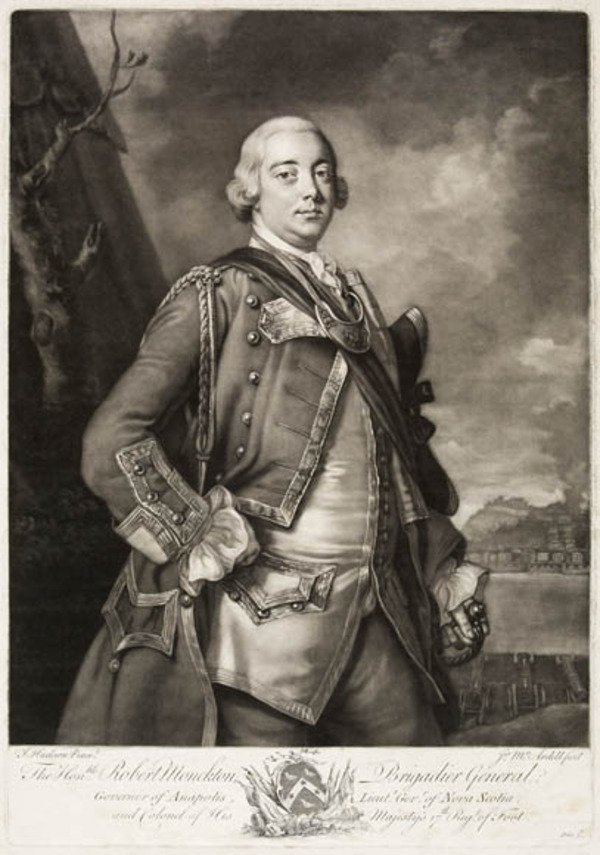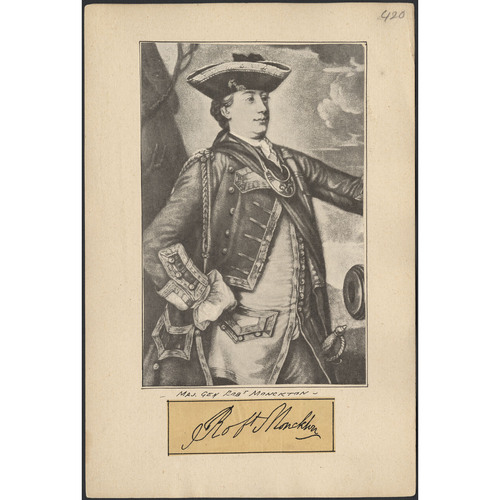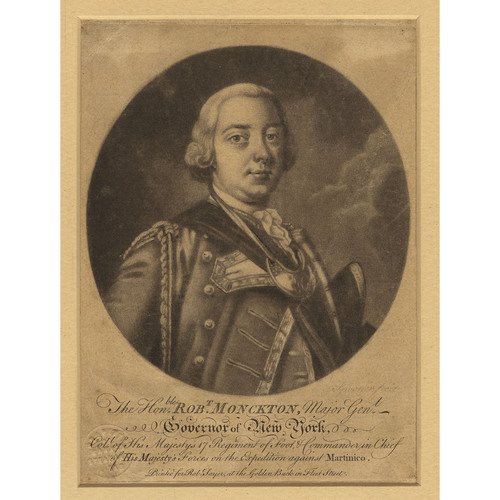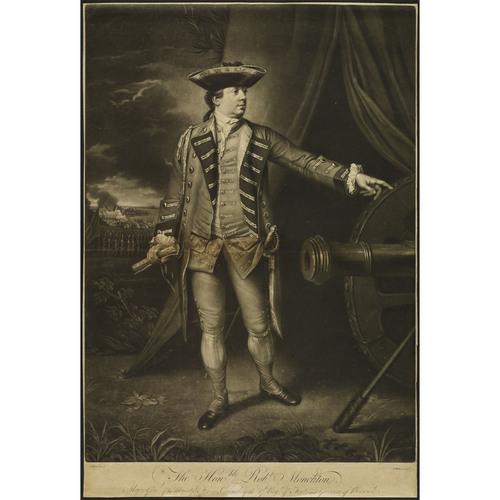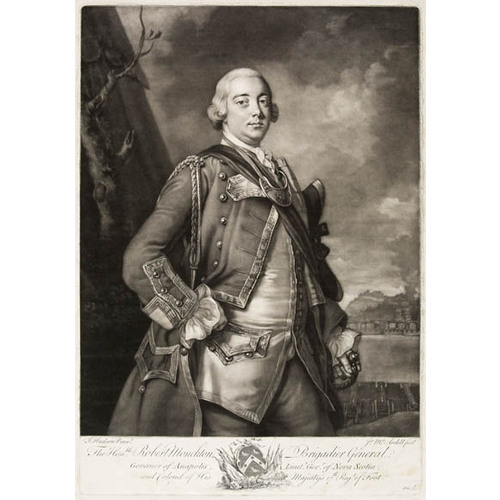MONCKTON, ROBERT, army officer and colonial administrator; b. 24 June 1726 in Yorkshire, England, second son of John Monckton, later lst Viscount Galway, and Lady Elizabeth Manners; d. 21 May 1782 in London, England. Although apparently never lawfully married, he raised and was survived by three sons and a daughter.
In 1741, at age 15, Robert Monckton was commissioned in the 3rd Foot Guards, which sailed to Flanders the following spring to serve in the War of the Austrian Succession. Monckton saw action at Dettingen (Federal Republic of Germany) and at Fontenoy (Belgium), staying on in Flanders after the British army was recalled to suppress the Jacobite rebellion in 1745. Commissioned captain in the 34th Foot on 27 June 1744, he was promoted major on 15 Feb. 1747/48 and lieutenant-colonel of the 47th Foot on 28 Feb. 1751/52. On his father’s death later that year Monckton became member of parliament for the family-controlled seat of Pontefract but was soon posted to Nova Scotia.
Monckton’s introduction to Canada was as commander of Fort Lawrence (near Amherst, N.S.), which faced the French Fort Beauséjour across the Missaguash River near Chignecto Bay. This military frontier was calm between his appointment in August 1752 and the following June; Monckton and Jean-Baptiste Mutigny de Vassan, his counterpart at Beauséjour, exchanged notes, deserters, and runaway horses. Undoubtedly both sides were also gathering intelligence and reinforcing prejudices. Called to Halifax in June 1753 to preside over a court martial, Monckton stayed on to accept membership in the colony’s Council.
German settlers at the new south shore community of Lunenburg were restive that autumn, and when news of an armed confrontation between the settlers and the local garrison reached the Council on 18 Dec. 1753, Monckton volunteered to lead a 200-man force to restore peace. Lieutenant Governor Charles Lawrence* and his Council advocated a reasonable approach so that “afterwards the consequences will lye on themselves should you be obliged to proceed to Extremitys.” Monckton was courteously received at Lunenburg and negotiated a return to order by what Lawrence called “moderate and most judicious measures” [see Jean Pettrequin* and Sebastian Zouberbuhler].
The aftermath, however, reveals the contrast between Monckton’s humane perspective and the sterner views of his superior, Lawrence. Having disarmed the settlers peaceably and traced the source of the rumours that had caused the trouble, Monckton then advocated forgiveness. Lawrence would not accept this counsel and informed Monckton rather ominously: “. . . tho the merciful part is always the most agreable (particularly with Foreigners unacquainted with our laws and Customs) in disturbances of this nature, yet it is seldom the most effectual.” Though one of the participants in the troubles was imprisoned for crimes and misdemeanors after Lawrence tried but failed to obtain a charge of high treason against him, most of the lieutenant governor’s suggestions for legal retribution were ignored.
Robert Monckton’s most memorable independent military command in North America was the successful campaign against the Chignecto forts, Beauséjour and Gaspereau (near Port Elgin, N.B.), in June 1755. Lawrence had joined Massachusetts Governor William Shirley in preparing the plan of operations during the preceding winter, based upon a general British order to counter French “encroachments.” Monckton spent the winter in Boston using his knowledge of Fort Beauséjour in detailed preparation for the attack. Here he quarrelled with John Winslow, one of his subordinate commanders, and relations between the two men were poor throughout the campaign. A convoy of 31 transports and three warships left Boston on 19 May 1755, carrying nearly 2,000 New England provincial troops and 270 British regulars, and dropped anchor near the mouth of the Missaguash River on 2 June. Secrecy and careful planning resulted in an unopposed landing and relatively light resistance as Monckton’s troops moved to invest Fort Beauséjour two days later. The garrison under Louis Du Pont Duchambon de Vergor, though outnumbered more than four to one, should have been able to resist longer than two weeks. Monckton’s careful professional approach along a ridge northeast of the fort had hardly begun when the disheartened defenders proposed terms of capitulation on 16 June. Monckton granted the garrison passage to Louisbourg, Île Royale (Cape Breton Island), and pardoned Acadian irregulars who had taken up arms under threat of death. The next day Benjamin Rouer* de Villeray, the commander of Fort Gaspereau, accepted the same terms without a shot being fired. Monckton’s success in the campaign was based upon surprise and good deployment of superior resources.
Precipitate collapse of the French defence of the Chignecto Isthmus left Monckton and Lawrence in command of an army of some 2,500 men, most of whom had volunteered for a whole year and all of whom were being paid and provisioned by the British government; in fact, unknown to the Treasury, the operation was being financed out of the annual parliamentary grant for the administration of Nova Scotia. Following supplementary orders, Monckton dispatched a small squadron to investigate the situation at the mouth of the Saint John River (N.B.), and by 2 July he had learned that the French garrison there had blown up its fort and retired. With his major responsibilities carried out so quickly, Monckton used his own men and hired Acadians to repair Fort Beauséjour (renamed Fort Cumberland) and to improve area roads. Many of the local inhabitants surrendered their arms, including the prominent partisan Joseph Brossard*, dit Beausoleil. But when the Acadian deputies negotiating with Lawrence refused the unqualified oath of allegiance, as they had done successfully for decades, Lawrence used his unprecedented military forces to respond with unprecedented severity: he ordered the expulsion of the Acadians. With characteristic efficiency but no apparent enthusiasm, Monckton carried out his orders to lure the inhabitants into custody, to burn their villages, and to supervise the deportation of the 1,100 people he collected in Chignecto.
Sole victor in a year of British defeats in North America, Monckton was made lieutenant governor of Nova Scotia in December 1755. During the next three years he acted as governor twice, both times handling preparations for the colony’s first legislature. He was thus occupied in the summer of 1758 when Amherst captured Louisbourg. That autumn he was given command of an expedition to scourge the Saint John River country (N.B.). A force of nearly 2,300 men, including the 2nd battalion Royal American Regiment (60th Foot) of which Monckton was now colonel, provided the base and advance troops for a cautious, deliberate expedition which destroyed houses, cattle, and crops for some 70 miles up the river. Few people were captured, but the expedition’s purpose was to force any Acadians raiding British-held territory to retire to Quebec by spring. Begun on 11 September, the operation was completed on 21 November. Early in 1759 Amherst called Monckton south to New York, intending he should command the southern region. Monckton was still in New York when James Wolfe* chose him to be second in command in the campaign against Quebec that summer.
Monckton’s role in the capture of Quebec was considerable. Shortly after the arrival of the British fleet at Quebec [see Sir Charles Saunders], Monckton led the four regiments that established control of the south shore of the St Lawrence River at Pointe-Lévy (Lauzon and Lévis). Initially intended to protect the fleet, this position was soon used by Wolfe to establish powerful batteries facing the city. Monckton commanded the unsuccessful attempt to land on the Beauport shore on 31 July, though he had been sceptical of the plan. As the summer wore on, Wolfe’s frustration prompted harsh measures against vulnerable settlements. There is evidence that Monckton delayed and moderated the execution of these orders in his command on the south shore. Tension between Monckton and Wolfe appeared briefly, though it was not as serious as Wolfe’s differences with the other senior members of his staff. At the end of August, Wolfe asked his brigadiers for their written opinion on three alternative battle plans, all focusing on the Beauport shore. Monckton, Murray, and George Townshend* rejected all three plans, and proposed attacking above Quebec – a concept which proved successful. Monckton commanded the crucial landing at Anse au Foulon early on 13 September and the British right on the Plains of Abraham later that day, being wounded through the chest during the battle. He resented Townshend’s excluding him from the negotiations for the capitulation of the city and recovered quickly enough to assume command of the city and its environs. In the month he served in this capacity Monckton displayed firmness in punishing soldiers who committed crimes and showed concern for the civilian population. One of his last orders, urging commanders not to allow their men to marry local girls, was a grudging admission that the army’s relations with the Canadians were improving.
Monckton left Quebec for New York on 26 October. Honours were mixed with new responsibilities; he had been made colonel of the 17th Foot earlier that month and on 29 April 1760 became commander of the British troops in the southern provinces. In February 1761 he was promoted major-general and on 20 March became governor and commander-in-chief in the province of New York. Monckton crowned his successful military career the following winter as commander of the army that captured the West Indian island of Martinique. His overwhelming forces took the supposedly impregnable French position within three weeks of landing. The terms of capitulation, modelled on the surrender of Guadeloupe in 1759 with minor changes, suggest that Monckton was a careful and well-informed negotiator. By June 1762 he was back at his post in New York. Monckton left North America for England on 28 June 1763, though he retained the governorship of New York until 14 June 1765, and was subsequently regarded as a “friend of America.” After exoneration by a court martial in 1764 on charges brought by a dismissed officer, Monckton became governor of Berwick-upon-Tweed on 14 June 1765 and was promoted lieutenant-general in 1770.
Luckless investment in the East India Company in this turbulent period of its history stimulated Monckton’s interest in, and need for, a post in India. Though he first had royal support, and later had the company’s nomination, he was not appointed commander-in-chief of the army there. He declined the government’s alternative offer of the command of the army in America when that post became vacant but accepted a valuable land grant on the West Indian island of St Vincent. In 1774 he served briefly again as mp for Pontefract, but seems to have played no part in the Coercive Acts or the Quebec Act.
Governor of Portsmouth, England, from 1778, and mp for the town in the Admiralty interest, Monckton held these positions until his death in 1782. He was buried in St Mary Abbot’s Church, Kensington (London).
BL, Add. mss 21638. Huntington Library, Loudoun papers. Library of Congress (Washington), Peter Force papers, VIII-D, Robert Monckton, correspondence, 1754–63. Newberry Library (Chicago), Edward E. Ayer coll., ms 341. Northamptonshire Record Office (Northampton, Eng.), Monckton of Fineshade records. PAC, MG 18, M. PRO, PRO 30/8, bundle 98. University of Nottingham Library (Nottingham, Eng.), Manuscripts Dept., Galway mss, 11599, 11601–3, 11611. Correspondence of William Pitt (Kimball), II, 69, 163, 302. N.S. Archives, I, 269, 270, 376, 393–400, 443, 444, 448. DAB. DNB. D. H. Monckton, A genealogical history of the family of Monckton . . . (London, 1887). J. C. Webster, The forts of Chignecto; a study of the eighteenth century conflict between France and Great Britain in Acadia ([Shediac, N.B.], 1930), 49–50, 53–60, 110–16.
Cite This Article
I. K. Steele, “MONCKTON, ROBERT,” in Dictionary of Canadian Biography, vol. 4, University of Toronto/Université Laval, 2003–, accessed December 30, 2025, https://www.biographi.ca/en/bio/monckton_robert_4E.html.
The citation above shows the format for footnotes and endnotes according to the Chicago manual of style (16th edition). Information to be used in other citation formats:
| Permalink: | https://www.biographi.ca/en/bio/monckton_robert_4E.html |
| Author of Article: | I. K. Steele |
| Title of Article: | MONCKTON, ROBERT |
| Publication Name: | Dictionary of Canadian Biography, vol. 4 |
| Publisher: | University of Toronto/Université Laval |
| Year of publication: | 1979 |
| Year of revision: | 1979 |
| Access Date: | December 30, 2025 |


